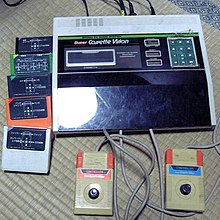History of video games/Platforms/Super Cassette Vision
Jump to navigation
Jump to search

Despite the name, the Super Cassette Vision actually used cartridges, as shown here.
-
The Super Cassette Vision with two controllers, one with a red accent and one with a blue accent.
History
[edit | edit source]
Launch
[edit | edit source]The Super Cassette Vision was released by Epoch in 1984 to replace the older 1981 Epoch Cassette Vision and the cost reduced 1983 Epoch Cassette Vision Jr.[1]
On launch the Super Cassette Vision sold well in Japan, as well as in France.[2]
The Super Cassette Vision Lady was launched in 1985 and marketed to women.[3][4][1] This was the first notable console to pursue this strategy, later followed by others such as the Casio Loopy.[5]
Technology
[edit | edit source]Compute
[edit | edit source]The Super Cassette Vision used an 8-bit NEC PD7801G CPU (Based on the Z80) clocked at 4 megahertz.[6]
The system had 128 bytes of RAM and four kilobytes of VRAM.[6]
Notable games
[edit | edit source]- Lupin III
- Dragon Ball: Dragon Daihikyō
- Miner 2049er
- Boulder Dash
- Doraemon Nobita's Time Machine the Great Adventure
- Mappy
- Pole Position II
Gallery
[edit | edit source]Super Cassette Vision
[edit | edit source]Motherboard
[edit | edit source]References
[edit | edit source]| Parts of this page are based on materials from: Wikipedia: the free encyclopedia. |
- ↑ a b "Japanese Company Made Consoles For Girls, And Also Cute Toys". Kotaku. Retrieved 24 October 2020.
- ↑ "Epoch Super Cassette Vision (1984 - late 1980s)". Museum of Obsolete Media. 8 March 2014. Retrieved 28 October 2020.
- ↑ "Super Lady Cassette Vision – The Video Game Kraken". Retrieved 27 November 2020.
- ↑ "The Most Unusual Video Game Consoles" (in en). PCMAG. https://www.pcmag.com/news/the-most-unusual-video-game-consoles. Retrieved 24 October 2020.
- ↑ Packwood, Lewis (15 July 2018). "In the Loopy: the story of Casio's crazy 90s console" (in en). Eurogamer. https://www.eurogamer.net/articles/2018-07-15-in-the-loopy-the-story-of-casios-crazy-90s-console. Retrieved 24 October 2020.
- ↑ a b "OLD-COMPUTERS.COM : The Museum". www.old-computers.com. Retrieved 29 October 2020.











